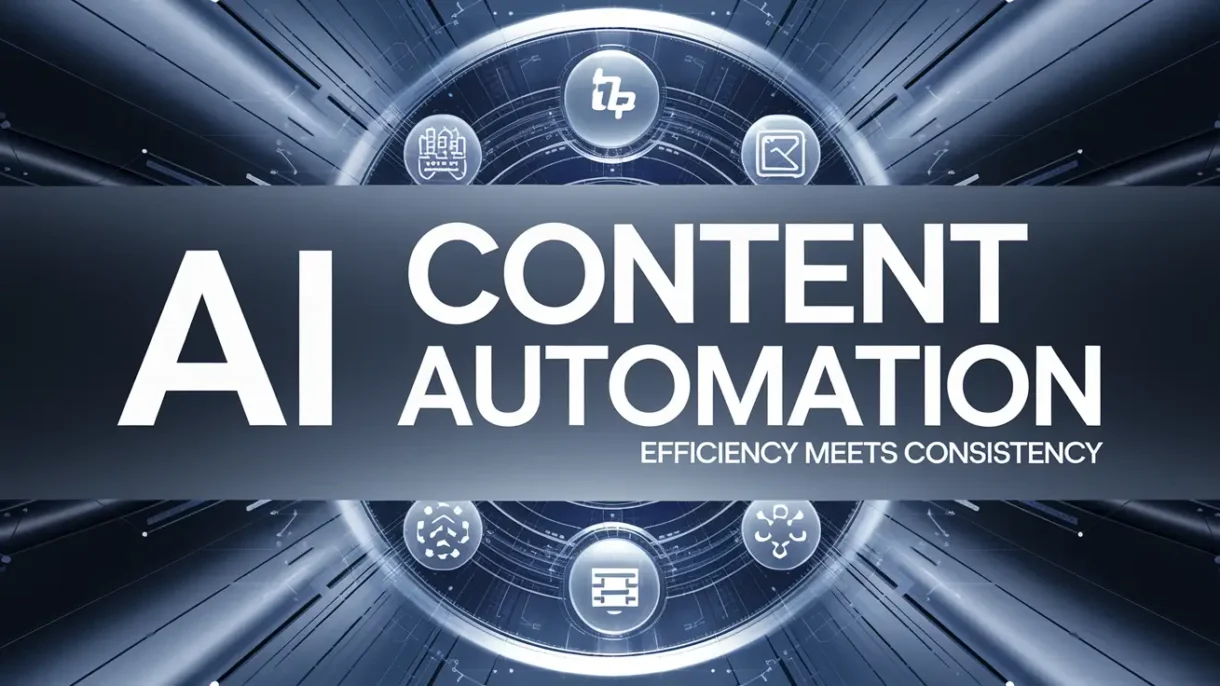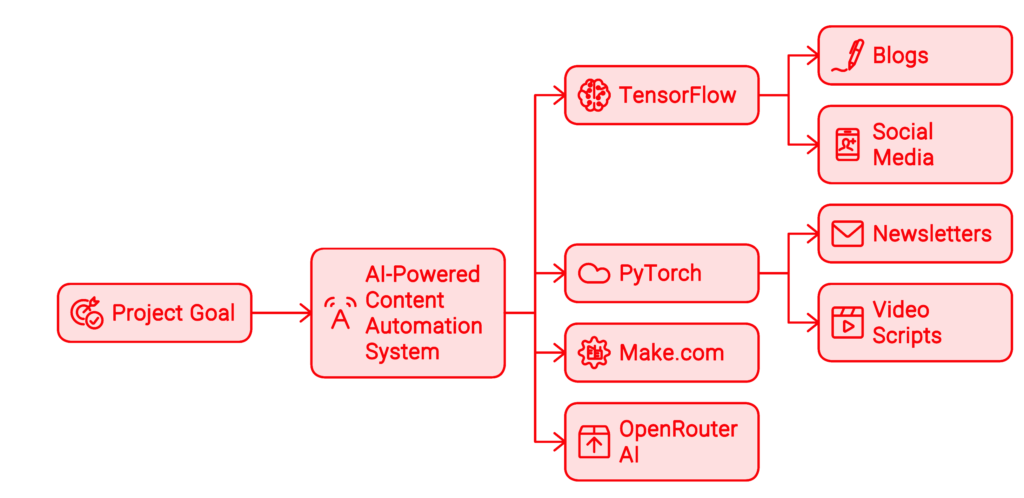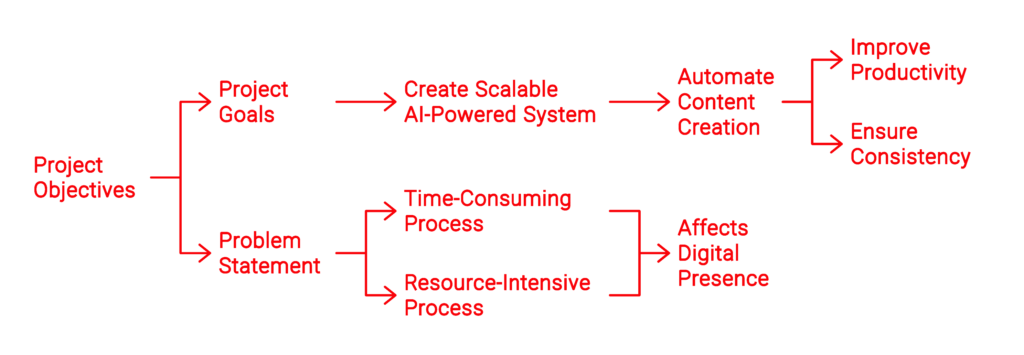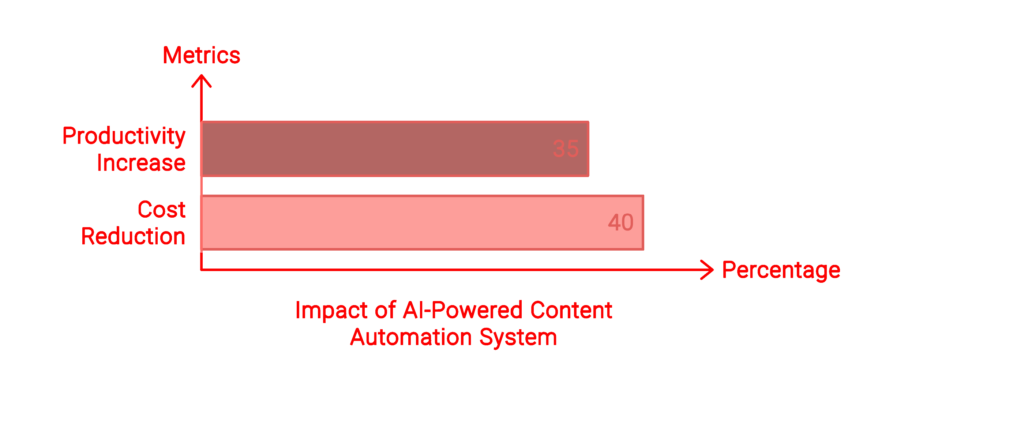
AI-Driven Content Automation
#AIContentCreation, #Automation, #MachineLearning
There are always some stocks, which illusively scale lofty heights in a given time period. However, the good show doesn’t last for these overblown toxic stocks as their current price is not justified by their fundamental strength.
Project Brief
Developed an AI-powered system to automate content creation, improving efficiency and consistency across various platforms.
- Automates content generation.
- Enhances productivity and consistency.
- Reduces costs and manual effort.
Tools Used
Leveraged TensorFlow, PyTorch, Make.com, and OpenRouter AI to build a robust content
automation system.
- TensorFlow for AI model development.
- PyTorch for deep learning and content generation.
- Make.com for workflow automation
Project Type
AI Automation and Content Generation
The “Revolutionizing Content Creation with AI Automation” project was designed to address he growing need for efficient and scalable content production in various industries, including retail, healthcare, and finance. The project aimed to develop a sophisticated AI-powered content automation system capable of generating high-quality content across multiple platforms, such as blogs, social media, newsletters, and video scripts. This system was built using advanced AI technologies like TensorFlow, PyTorch, Make.com, and OpenRouter AI, ensuring a seamless and efficient content creation process.

Step 1: Conceptualization
The project began with the identification of a critical need within businesses for a more streamlined content creation process. The core idea was to develop an AI system that could automate repetitive tasks like writing blog posts, generating social media content, and creating video scripts, thereby freeing up human resources to focus on more strategic initiatives. The vision was to create a solution that not only enhances productivity but also ensures the consistent delivery of high-quality content.
Step 2: Planning and Strategy
A comprehensive strategy was developed to ensure the successful implementation of the AI automation system. This included defining the project’s goals, setting a timeline, and allocating resources for the development and integration of various AI tools and technologies. The strategy focused on creating a scalable solution that could be easily adapted to different business needs and integrated with existing platforms.
Step 3: Design and Prototyping
During the design phase, initial prototypes of the AI models were developed to test their effectiveness in generating various types of content. The design process involved creating workflows that could automate content creation tasks while maintaining a high level of quality and consistency. These prototypes were refined through multiple iterations to ensure they met the project’s objectives.
Step 4: Development and Implementation
The development phase involved building and deploying AI models using TensorFlow and PyTorch, which were then integrated with automation platforms like Make.com and OpenRouter AI. The AI models were trained on large datasets to ensure they could generate content that resonated with the target audience. The implementation phase also included setting up automated workflows that allowed the system to operate seamlessly across different content platforms.
Step 5: Testing and Refinement
Extensive testing was conducted to ensure the AI system’s ability to generate high-quality content consistently. The testing phase involved evaluating the system’s performance across different types of content and making necessary adjustments to improve accuracy and relevance. The AI models were fine-tuned to ensure they could handle the nuances of various industries, such as retail, healthcare, and finance.
Step 6: Final Delivery and Launch
The final system was delivered and launched, providing businesses with a powerful tool to automate their content creation processes. The launch included comprehensive training for users to ensure they could effectively utilize the system. The AI-powered content automation system was deployed across multiple platforms, helping businesses to maintain a consistent brand voice and improve their overall digital presence.
Step 7: Post-Launch Support
Post-launch, ongoing support was provided to ensure the system’s continued success. This included monitoring the system’s performance, gathering user feedback, and implementing updates as needed. The support phase also involved planning for future enhancements, such as integrating new AI tools and expanding the system’s capabilities to cover additional content types.
This project represents a significant advancement in the field of content automation, providing businesses with a scalable and efficient solution to manage their content creation needs. By leveraging the latest AI technologies, the system has not only improved productivity but also ensured the consistent delivery of high-quality content, making it a valuable asset for any business looking to enhance its digital marketing efforts.
7. Objectives:
Project Goals: To create a scalable AI-powered system that automates the creation of various types of content, improving productivity and consistency across platforms.
Problem Statement: Businesses struggle with the time-consuming and resource-intensive process of content creation, which affects their ability to maintain a consistent digital presence.

8. My Role:
Role and Responsibilities: As the Lead AI Engineer and Project Manager, I was responsible for overseeing the development and integration of the AI models, managing the project’s timeline, and ensuring the successful implementation of the content automation system.
Team Collaboration: Collaborated with data scientists, developers, and business analysts to ensure the AI models met the project’s objectives and were effectively integrated into the client’s existing systems.
9. Process/Methodology:
Approach: Utilized Agile methodology to allow for iterative development and continuous testing, ensuring the AI models were refined and optimized throughout the project.
Tools and Technologies: TensorFlow, PyTorch, Make.com, OpenRouter AI for developing, deploying, and integrating the AI models into automated workflows.
Key Steps: Conceptualization, design and prototyping, development and implementation, testing and refinement, final delivery, and post-launch support.
10. Challenges and Solutions:
Challenges Faced: The primary challenges included ensuring the AI models could generate high-quality content across different formats and industries, as well as integrating the models seamlessly with existing business platforms.
Solutions Implemented: Developed robust AI models trained on large, diverse datasets to handle various content types and industry-specific nuances. Used Make.com and OpenRouter AI to create custom workflows that facilitated seamless integration and automation.
11. Results and Impact
Outcomes : The AI-powered content automation system increased productivity by 35%, reduced content creation costs by 40%, and ensured a consistent brand voice across all platforms.
Client/Stakeholder Feedback: Clients reported significant improvements in their content production process, with faster turnaround times and higher-quality outputs.
Impact: The project has empowered businesses to enhance their digital presence, improve engagement with their target audience, and maintain a competitive edge in their respective markets.


